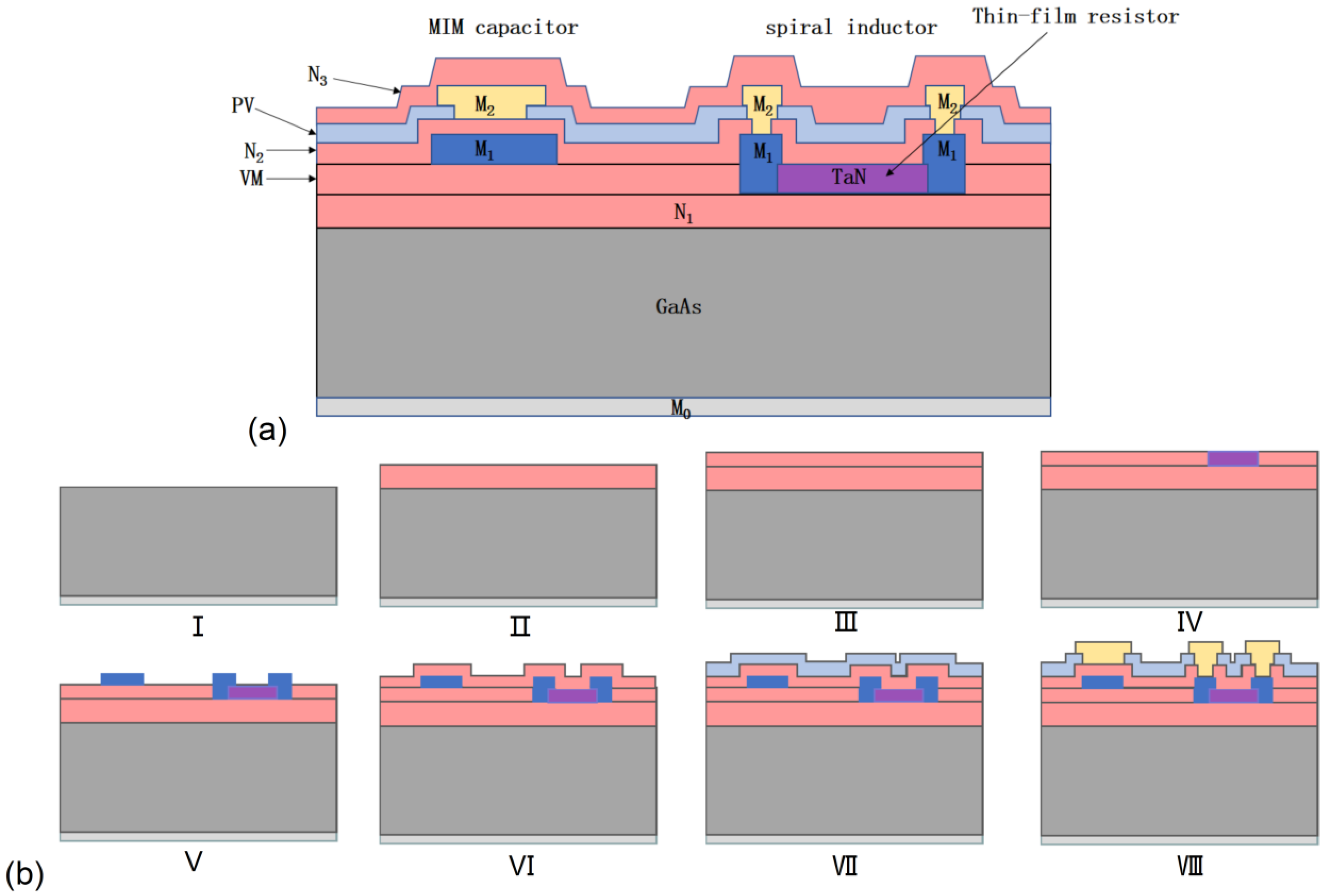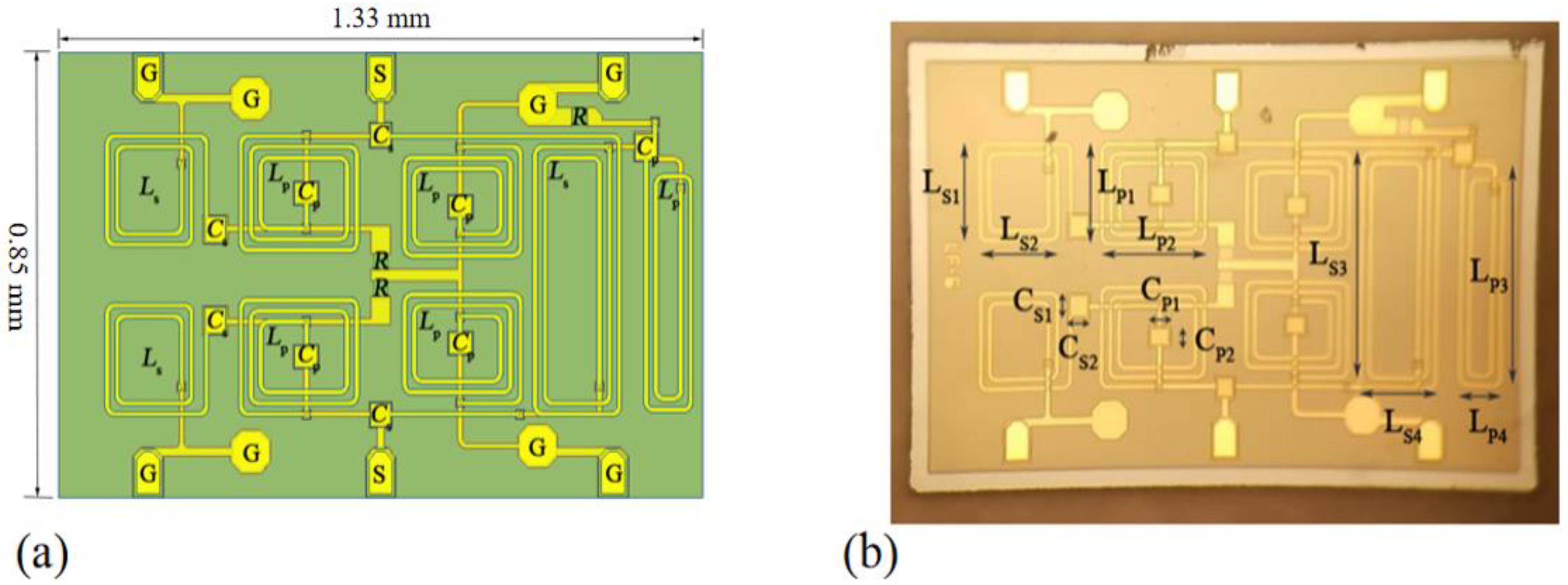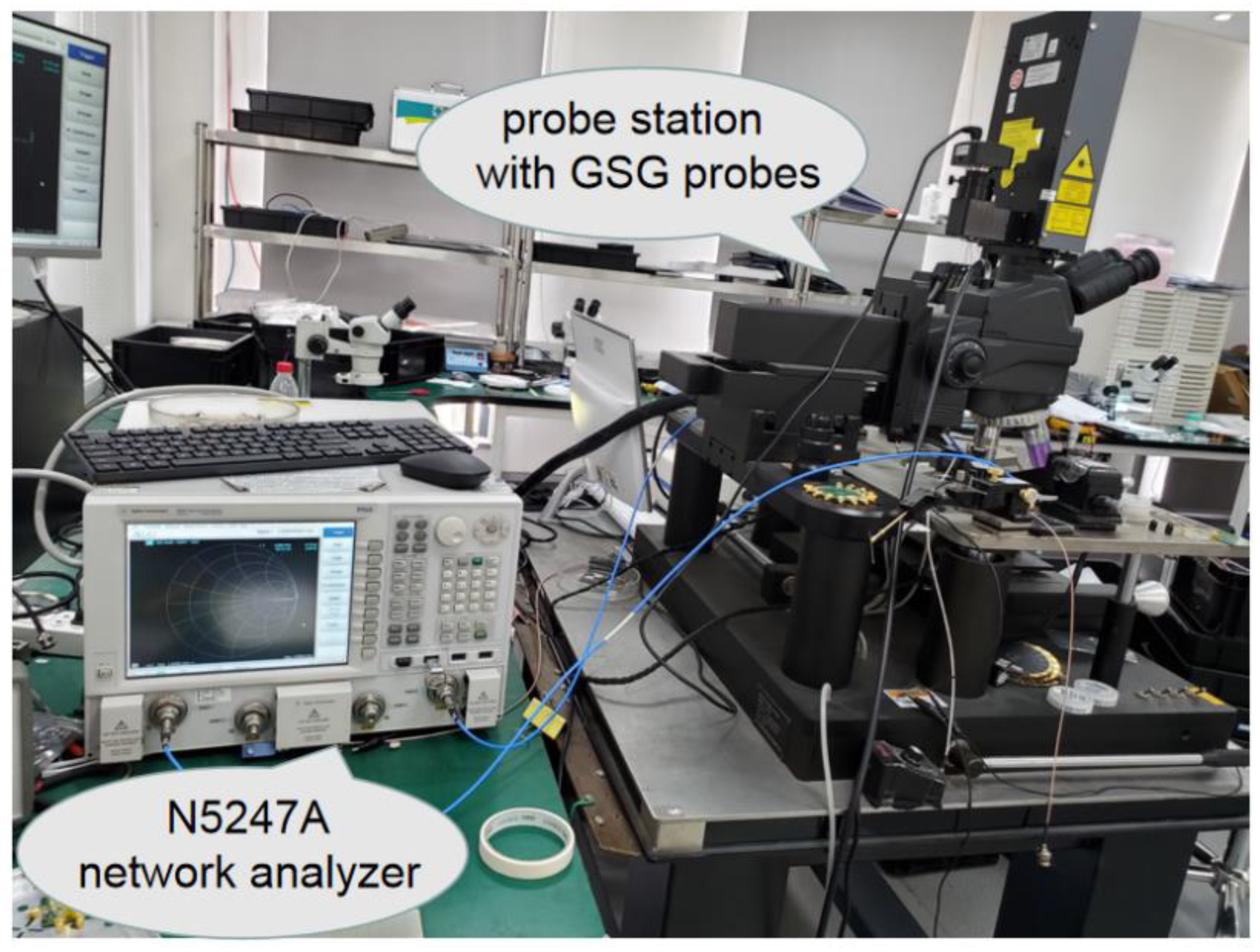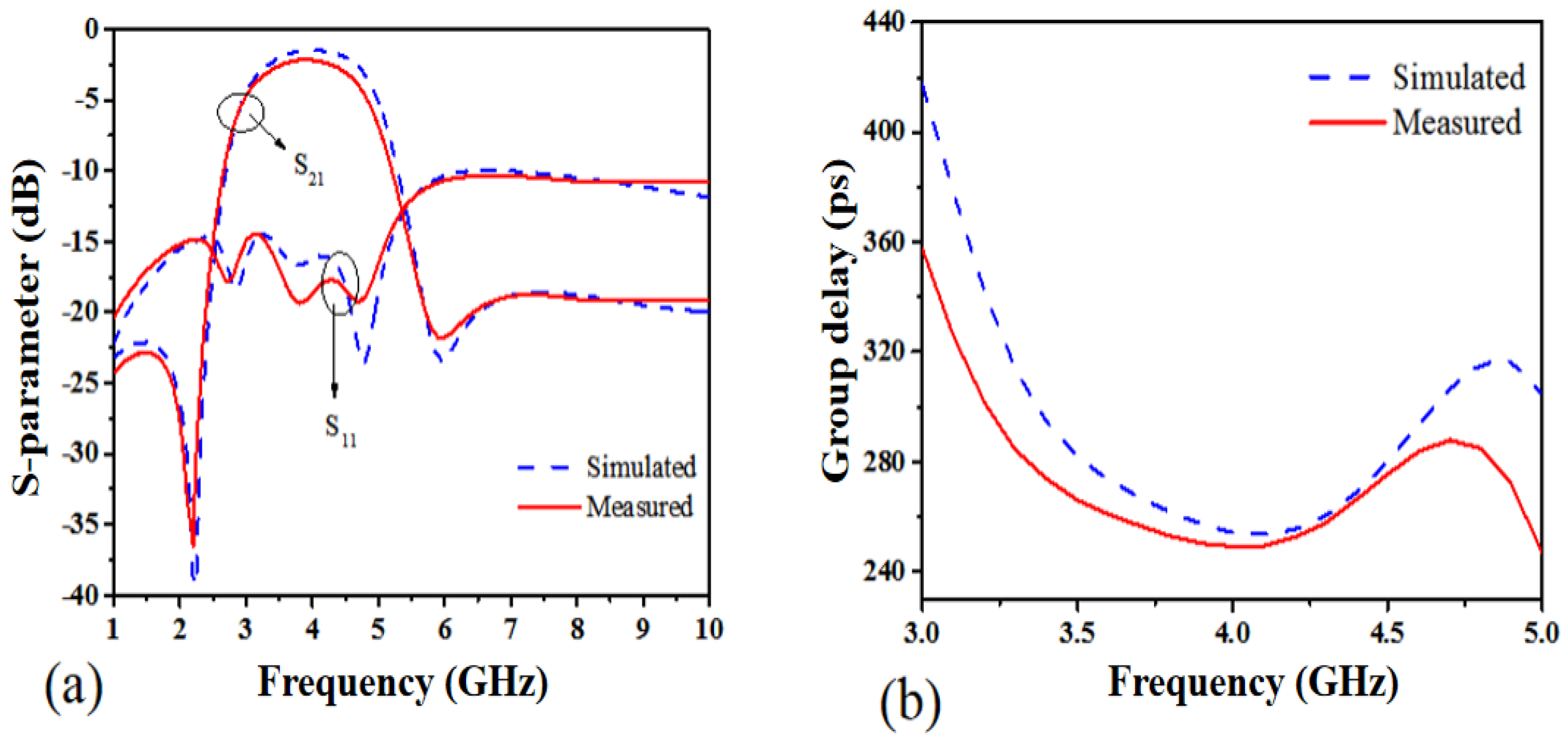Compact, Reflectionless Band-Pass Filter: Based on GaAs IPD Process for Highly Reliable Communication
Abstract
:1. Introduction
2. Circuit Design and Fabrication Process
3. Results and Discussion
4. Conclusions
Author Contributions
Funding
Conflicts of Interest
References
- Jiang, Y.; Tang, W.C.; Shi, Y.R.; Zhou, P.; Feng, L.P. Compact and low insertion loss UWB on-chip band-pass filter using coupled meandered line. Microw. Opt. Technol. Lett. 2020, 62, 2236–2242. [Google Scholar] [CrossRef]
- Kim, D.M.; Min, B.W.; Yook, J.M. Compact mm-wave band-pass filters using silicon integrated passive device technology. IEEE Microw. Wirel. Compon. Lett. 2019, 29, 638–640. [Google Scholar] [CrossRef]
- Shen, G.X.; Che, W.Q. Compact Ku-band LTCC band-pass filter using folded dual-composite right- and left-handed resonators. Electron. Lett. 2020, 56, 17–18. [Google Scholar] [CrossRef]
- Guilabert, A.; Morgan, M.A.; Boyd, T.A. Reflectionless filters for generalized transmission functions. IEEE Trans. Circuits Syst. I Regul. Pap. 2019, 66, 4606–4618. [Google Scholar] [CrossRef]
- Morgan, M.A.; Boyd, T.A. Theoretical and experimental study of a new class of reflectionless filter. IEEE Trans. Microw. Theory Tech. 2011, 59, 1214–1221. [Google Scholar] [CrossRef]
- Morgan, M.A.; Boyd, T.A. Reflectionless Filter Structures. IEEE Trans. Microw. Theory Tech. 2015, 63, 1263–1271. [Google Scholar] [CrossRef] [Green Version]
- Morgan, M.A. Think outside the band: Design and miniaturization of absorptive filters. IEEE Microw. Mag. 2018, 19, 54–62. [Google Scholar] [CrossRef]
- Qin, W.W.; Shi, Y.; Zhao, B.L. Simulation design of a novel micro-strip absorption band-pass filter. J. Magn. Mater. Devices 2015, 46, 50–54. [Google Scholar]
- Navjot, K.K.; Tejinder, S.; Raafat, R.M. Monolithically integrated RF MEMS-based variable attenuator for millimeter-wave applications. IEEE Trans. Microw. Theory Tech. 2019, 67, 3251–3259. [Google Scholar]
- Khalaj, A.M.; Taskhiri, M.M. Two fold reflectionless filters of inverse-Chebyshev response with arbitrary attenuation. IEEE Trans. Microw. Theory Tech. 2017, 65, 4616–4620. [Google Scholar] [CrossRef]
- Psychogiou, D.; Simpson, D.J.; Gómez, G.R. Input-reflectionless acoustic-wave-lumped-element resonator-based band-pass filters. In Proceedings of the IEEE/MTT-S Microwave Symposium, Philadelphia, PA, USA, 10–15 June 2018; pp. 852–855. [Google Scholar]
- Lee, T.H.; Lee, B.; Lee, J. First-order reflectionless lumped-element low-pass filter (LPF) and band-pass filter (BPF) design. In Proceedings of the IEEE/MTT-S Microwave Symposium, San Francisco, CA, USA, 22–27 May 2016; pp. 1–4. [Google Scholar]
- Chien, S.H.; Lin, Y.S. Novel wideband absorptive bandstop filters with good selectivity. IEEE Access 2017, 5, 18847–18861. [Google Scholar] [CrossRef]
- Gómez, G.R.; Muñoz, F.J.M.; Psychogiou, D. Symmetrical quasi-reflectionless BSFs. IEEE Microw. Wirel. Compon. Lett. 2018, 28, 302–304. [Google Scholar] [CrossRef]
- Shao, J.Y.; Lin, Y.S. Narrowband coupled-line bandstop filter with absorptive stop-band. IEEE Trans. Microw. Theory Tech. 2015, 63, 3469–3478. [Google Scholar] [CrossRef]
- Hagag, M.F.; Abdelfattah, M.; Peroulis, D. Balanced octave-tunable absorptive band-stop filter. In Proceedings of the IEEE 19th Wireless and Microwave Technology Conference, Sand Key, FL, USA, 9–10 April 2018; pp. 1–4. [Google Scholar]
- Chieh, J.C.S.; Rowland, J. A fully tunable C-band reflectionless band-stop filter using L-resonators. In Proceedings of the IEEE 46th European Microwave Conference, London, UK, 4–6 October 2016; pp. 131–133. [Google Scholar]
- Liu, G.; Xing, M.; Li, X.; Xu, S.; Dai, C. Design of a Miniaturized reflectionless band-pass filter with high selectivity for 5G network. In Proceedings of the 3rd International Conference on Mechatronics and Intelligent Robotics, Kunming, China, 25–26 May 2019; pp. 585–593. [Google Scholar]
- Gómez, G.R.; Muñoz, F.J.M.; Wang, F.; Psychogiou, D. Balanced symmetrical quasi-reflectionless single- and dual-band band-pass planar filters. IEEE Microw. Wirel. Compon. Lett. 2018, 28, 798–800. [Google Scholar] [CrossRef]
- Lin, T.Y.; Haung, Y.C.; Wu, T.L. Novel absorptive balanced band-pass filters using resistive loaded transmission lines. IEEE Trans. Compon. Pack. Manuf. Technol. 2019, 9, 745–753. [Google Scholar] [CrossRef]
- Gomez, G.R.; Muñoz, F.J.M.; Psychogiou, D. Dual-behavior resonator-based fully reconfigurable input reflectionless band-pass filters. IEEE Microw. Wirel. Compon. Lett. 2019, 29, 35–37. [Google Scholar] [CrossRef]
- Morgan, M.A. Reflectionless Filters; Artech House: Norwood, MA, USA, 2017; p. 59. [Google Scholar]





| Low-Pass Filter | Band-Pass Filter |
|---|---|
| LS1 | LS2 | LS3 | LS4 | LP1 | LP2 |
|---|---|---|---|---|---|
| 210 | 180 | 502 | 180 | 220 | 244 |
| LP3 | LP4 | CS1 | CS2 | CP1 | CP2 |
| 460 | 100 | 54 | 50 | 52 | 44 |
| Reference | Process | Structure | Size (mm) | Component Number | |S11| (dB) | |S21| (dB) | Center Frequency (GHz) |
|---|---|---|---|---|---|---|---|
| [5] | SMD | Third order BPF | / | 18 | 15 | 12 | 0.18 |
| [5] | SMD | Cascaded filter with three third-order BPF | / | 54 | 15 | 42 | 0.18 |
| [6] | IPD | Third order BPF | 1 × 1 | 18 | 16 | 15 | 2.6 |
| [7] | IPD | Cascaded filter with three HPFs and three LPFs | 2 × 2 | 20 | 8 | 15 | 5 |
| This work | IPD | Improved third order BPF | 0.8 × 1.3 | 21 | 10 | 20 | 3.9 |
Publisher’s Note: MDPI stays neutral with regard to jurisdictional claims in published maps and institutional affiliations. |
© 2021 by the authors. Licensee MDPI, Basel, Switzerland. This article is an open access article distributed under the terms and conditions of the Creative Commons Attribution (CC BY) license (https://creativecommons.org/licenses/by/4.0/).
Share and Cite
Li, X.; Xing, M.; Liu, G.; Yang, X.; Dai, C.; Hou, M. Compact, Reflectionless Band-Pass Filter: Based on GaAs IPD Process for Highly Reliable Communication. Electronics 2021, 10, 2998. https://doi.org/10.3390/electronics10232998
Li X, Xing M, Liu G, Yang X, Dai C, Hou M. Compact, Reflectionless Band-Pass Filter: Based on GaAs IPD Process for Highly Reliable Communication. Electronics. 2021; 10(23):2998. https://doi.org/10.3390/electronics10232998
Chicago/Turabian StyleLi, Xiaozhen, Mengjiang Xing, Gan Liu, Xiaodong Yang, Chuanxiang Dai, and Ming Hou. 2021. "Compact, Reflectionless Band-Pass Filter: Based on GaAs IPD Process for Highly Reliable Communication" Electronics 10, no. 23: 2998. https://doi.org/10.3390/electronics10232998
APA StyleLi, X., Xing, M., Liu, G., Yang, X., Dai, C., & Hou, M. (2021). Compact, Reflectionless Band-Pass Filter: Based on GaAs IPD Process for Highly Reliable Communication. Electronics, 10(23), 2998. https://doi.org/10.3390/electronics10232998





